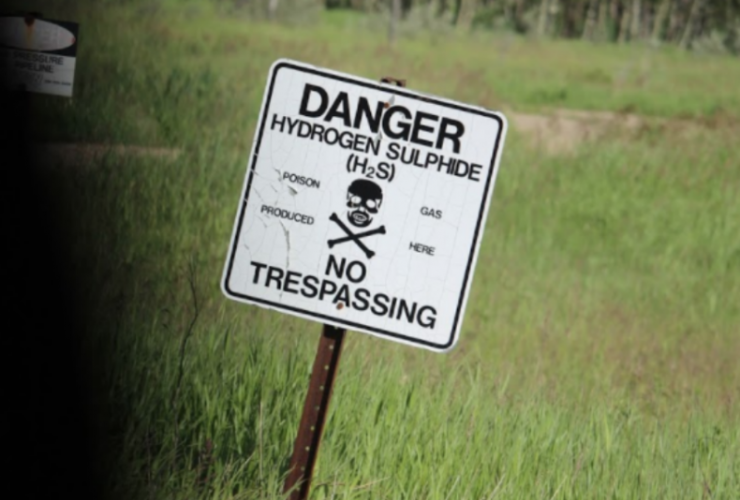In the Prairies, where oil and gas sites sprinkle much of land, researchers are calling attention to a little-known chemical pollutant the fossil fuel industry has for decades released into the natural environment. Sulfolane was long thought to be harmless but now there is growing evidence of its toxicity, and emerging calls to clean it up.
Sulfolane was first used in the 1940s by Shell, and has since been broadly adopted by the industry. In Alberta, it is used heavily to “sweeten” sour gas (which makes up a third of natural gas in the province) by removing acidic components from it, explains researcher Erica Pensini, an associate professor of engineering at the University of Guelph. There is little data on the impact of the chemical on humans, but it has been shown to affect fertility in cattle, and Health Canada notes that “overall, oral exposure to sulfolane in experimental animals was associated with immunological, renal and reproductive and developmental effects.”
In collaboration with Canadian Light Source — a national research facility out of the University of Saskatchewan — Pensini and others from Guelph have begun studying how sulfolane moves in water. It’s the first step to identifying where sulfolane deposits are in Alberta’s waterways — information Pensini hopes will lead to remediation efforts. They’ve noted that sulfolane travels and mixes easily with groundwater: an especially pertinent concern for rural residents who rely on wells for drinking water.
While it’s known sulfolane has been used for years by the fossil fuel industry in the Prairies and beyond, there are no official figures on how much of the pollutant was dumped. However, Pensini notes, “We know [how] much oil and gas is produced in Alberta, we know that this process was widely used, we know that this chemical was just being washed up into aquifers. So, [we] expect the impacts are quite broad.”

Now that sulfolane is understood to be toxic, the fossil fuel industry takes precautions to keep it from leaching into groundwater; Pensini frames it as a “historical pollutant.” However, Canada’s National Observer reached out to the Alberta government to ask what disposal rules are around sulfolane, when they were put in place and if there are any remediation efforts underway, but did not receive a response by deadline.
Understanding how sulfolane acts in water is important because it has little smell or colour, explained Pensini. Like alcohol, it is “miscible” in water, which means it can mix completely with water. However, it behaves more like gasoline when natural salts (such as sulfates from minerals in aquifers) are present in waterways. In those instances, the speed at which it moves would likely decrease, she said.
Findings on the impacts of salt on the movement of sulfolane were published in the research journal, the Physics of Fluid in March. Now, Pensini and her fellow researchers are working to understand how sulfolane moves in groundwater when mixed with other pollutants, such as oil and gas.
Sulfolane leaks in Alberta
About a decade ago, people living in a rural area in Alberta experienced a sulfolane leak from a nearby gas plant that was owned by Suncor at the time and later sold to Bonavista Energy. During the investigation, it was revealed the Alberta government knew of a previous sulfolane leak and didn’t tell residents.
In 2014, Bonavista reported levels of sulfolane 125 times the safe amount recommended by Health Canada guidelines for drinking water near the site, reported CBC News. Paul Belanger lives in the area and explains that people “didn’t really know when the leak started.”
While the chemical hasn’t received much attention, Belanger says it's a big concern to those who understand its toxicity. He is a science adviser at Keepers of the Water and also used to work in the oil industry in Alberta. He explains that the industry long “knew nothing about the toxicity” and was “just dumping it on the ground.”
“We have lots of sour gas plants in Alberta. And so every single one of our sour gas plants has a sulfolane problem. It's all over. This is quite a serious issue,” he said while referencing a 2019 study done on aquatic organisms that showed negative health impacts when exposed to sulfolane.
A 2021 review of sulfolane studies published in the journal Environmental Reviews notes that “there is clear evidence of sulfolane toxicity in both aquatic and terrestrial organisms, which suggests that sulfolane would affect humans to a greater extent than some of the smaller test animals such as rodents.”
Sulfolane pollution isn’t an issue unique to the Prairies. In 2020, an Alaska refinery was charged millions in damages for releasing sulfolane and polluting hundreds of people’s wells. Belanger says the increase in studies showing its toxicity combined with the widespread use of the product show that awareness needs to be created among people, especially in the Prairies.
The government also needs to fund studies, independent of the Alberta Energy Regulator, which Belanger said has proven itself as opaque and untrustworthy, pointing to the regulator’s failure to notify Athabasca Chipewyan First Nation about two large leaks of toxic tailings from Imperial Oil’s Kearl site.
“The public needs to know more … we need direct information and then it has to be treated in places where it needs to be treated,” he said.
“It can be quite expensive, but very doable. And it's being done routinely in the States. We can do it here, too.”
Old Weibo Ludwig was right
Old Weibo Ludwig was right that his cattle at Trickle Creek in NW Alberta were being poisoned by sour gas or and sulfolane. And someone died due to irresponsible oil companies and regulatory bodies. And no one believed him.





Comments